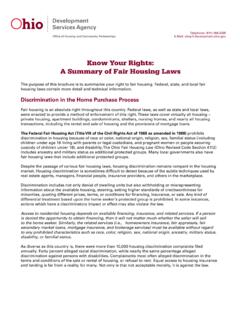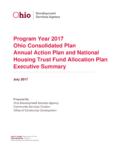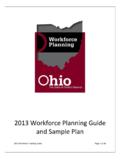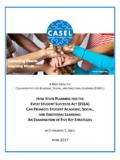Transcription of Program Year 2016 Ohio Consolidated Plan Annual Action ...
1 Program Year 2016 ohio Consolidated plan Annual Action plan executive summary June 2016 Prepared By: ohio Development Services Agency Community Services Division Office of Community Development John R. Kasich, Governor of ohio David Goodman, Director ohio Development Services Agency 1 Introduction This executive summary is being provided pursuant to the March 13, 2006 revisions to the Department of Housing and Urban Development (HUD) Consolidated plan regulations. Those regulations require that an executive summary be prepared, which must include: A summary of the citizen participation and consultation process (pages 1-2). A summary of proposed revisions (pages 3-10) Objectives and outcomes and an evaluation of past performance (pages 12-13) summary of Comments received (page 13) The ohio Development Service Agency s (ODSA s) Office of Community Development (OCD) annually receives funding from the Department of Housing and Urban Development (HUD) from four programs: the Community Development Block Grant (CDBG) Program , the HOME Investment Partnerships Program (HOME), the Emergency Solutions Grant (ESG) Program , and the Housing Opportunities for Persons With AIDS (HOPWA) Program .
2 Prior to receiving and distributing these funds, ohio must first prepare an Annual Consolidated plan in accordance with the requirement at 24 CFR Part 91 Subpart D, Sections HUD regulations require that, in preparing the Annual plan , the state must develop and follow a planning process that incorporates a citizen participation plan . The plan must include a method of distribution, as well as a description of other actions that will be undertaken in support of the state s proposed programs and activities. The revisions that are proposed in the PY 2016 ohio Consolidated plan Annual Action plan are summarized below. Only significant Program revisions are listed, not minor revisions. PY 2016 Citizen Participation and Consultation Process OCD completed a number of activities designed to obtain comments, perspectives, and citizen opinions to prepare the PY 2016 ohio Consolidated plan Annual Action plan . Notification of all public hearings and meetings was made at least 10 days in advance of the meetings through newsletters, direct mail and posting on OCD s website at Records of these actions and documentation are available for review at the OCD office between 8 and 5 at 77 South High Street, 26th floor in Columbus, ohio .
3 All facilities and meeting times selected as part of the citizen participation process were chosen to accommodate persons with disabilities. The specific citizen participation activities are described as follows. 1. Public Hearing On Needs OCD held a public hearing on needs issues on September 9, 2015, in Room 1960 on the 19th Floor of the Riffe Center, in Columbus. OCD mailed Notification of the Public Hearing on Needs information to approximately 1,000 local communities, organizations and agencies throughout the state at least 30 days in advance. DSA also published the notification on OCD s website. The notification summarized the state s planning process for the ohio Consolidated plan Annual Action plan , and solicited participation in OCD s Program Advisory Committee meetings. OCD accepted written comments on needs issues for 15 days prior to the meeting (from September 1, 2015 to September 16, 2015).
4 Comments made at the Public Hearing on Needs, or received by OCD prior to the conclusion of the hearing, were distributed to the advisory committee members for consideration during the planning process. 2. Program Advisory Committees OCD held eight Program Advisory Committees on September 29 and 30, 2015. At least 10 members comprised the Program Advisory Committees, including local officials, Program administrators, nonprofit organizations, and other agencies, organizations and individuals familiar with OCD's programs and/or the Housing Development Assistance Program administered by the ohio Housing Finance Agency (OHFA). OCD solicited participation on the Program Advisory Committees by directly mailing information to all local communities, organizations and persons on the OCD mailing list, which includes approximately 900 communities and organizations.
5 The mailing also provided notification about the Public Hearing on Needs. The following Program Advisory Committee meetings were held: 2 Community Development Program Advisory Committee Residential Public Infrastructure Grant Program Advisory Committee Fair Housing/New Horizons Program Advisory Committee Economic Development Program Advisory Committee Community Housing Impact and Preservation Program Advisory Committee Housing Development Assistance Program (HDAP) Advisory Committee Homeless Crisis Response Program / Housing Assistance Grant Program Advisory Committee Housing Opportunities for Persons with AIDS Program Advisory Committee 3. Consolidated plan Advisory Committee Meeting The PY 2016 ohio Consolidated plan Advisory Committee met on February 2, 2016, to review the Draft PY 2016 ohio Consolidated plan Annual Action plan . The ohio Consolidated plan Annual Action plan Advisory Committee is comprised of 21 persons who represent a variety of public and private organizations that are involved with programs and issues related to housing and community development.
6 4. Notification of Public Comment Period and Distribution of plan On March 1, 2016, OCD sent notification to approximately 900 communities, agencies and organizations, informing them that the Draft PY 2016 ohio Consolidated plan Annual Action plan and executive summary are available on OCD s website for review and comment at This notification will also announce the beginning of the mandatory 30-day public comment period on the draft plan , including a public hearing on March 17, 2016, at 1:30 at 77 South High Street, Room 1960, Columbus, ohio . All comments received have been included in the PY 2016 ohio Annual Action plan . Submission to HUD The final ohio Consolidated plan Annual Action plan document will be submitted via Integrated Disbursement Information and Information Systems (IDIS) to HUD for a 45-day review period on or before May 13, 2016. Posting notification and availability of the final PY 2016 ohio Consolidated plan Annual Action plan will be sent to approximately 1,000 communities, agencies and organizations throughout the state.
7 3 Program Year (PY) 2016 ohio Consolidated plan Annual Action plan summary of Proposed Revisions I. Community Housing Impact and Preservation Program (CHIP) The following changes are being proposed for PY 2016. Eligible Jurisdictions Having an approved Community Housing Improvement Strategy is longer a requirement for funding Cities must have an LMI percentage above 25% to be eligible for funding The list of jurisdictions that are eligible for funding has been updated based on a review of total population and percentage of LMI. Below are the communities that have been added or removed: Jurisdictions Added to the List of CDBG, HOME and OHTF Eligible Communities BellevueHeathOrrvilleWapakonetaCelinaHur onRichland CountyWauseonChardonIrontonRittm anWillardClydeLawrence CountyRossfordColumbianaMarion CountySt. Ma rysDelphosMaumeeTipp CityFindlayNew CarlisleTroy Jurisdiction Added to the List of HOME Eligible Communities Bowling Green Jurisdiction Added to the List of HOME Eligible Communities Hubbard Jurisdictions Removed from the list of Eligible Communities AuroraCortlandNorth RidgevilleSt.
8 Clairsville Partnership Composition Any eligible jurisdiction that chooses not to be a direct CHIP Program participant, either as an applicant or a partner, may do so with no effect on the applicant s scoring or funding level by selecting one of the following options: o County Umbrella Option: If an eligible city is not interested in being a partner but is interested in CHIP Program funds being spent in their jurisdiction, the city can join the service area through their county s jurisdiction. The application for funding must contain a letter from the city s CEO electing for CHIP Program funds to be spent in their community under their county s jurisdiction in order to receive points associated with partnership development. When determining the applicant s ceiling amount, the county s amount must be based on amounts outlined for counties under Single-Community Applicants, Column B or Partnership Applicants depending on whether the county has another partnering jurisdiction.
9 There are no incentive funds available for this option. The County may participate as a single applicant, a partnership applicant or a partner. o Jurisdiction Opt-Out Option: If an eligible jurisdiction has no intention to apply for CHIP Program funding and is not interested in CHIP Program services within its jurisdiction, the application for funding must contain an opt-out letter from the jurisdiction s CEO in order to 4 receive points associated with partnership development. The opt-out period must be for at least two years and must be stated in the opt-out letter. Such applicants must refer to Single-Community Applicants, Column B . This is an option only available to jurisdictions that are not interested in the CHIP Program at all and do not want funds spent in their jurisdiction, not for jurisdictions that choose not to partner. Non-entitlement cities and counties that are part of a participating jurisdiction consortium and entitlement/non-participating jurisdictions may choose to apply as single-community applicants.
10 Language previously required that they apply as single community applicants. These jurisdictions will automatically receive points associated with partnership development through application scoring or join an eligible partnership with the following restrictions: o A non-entitlement/non-participating jurisdiction (see #1, Eligible Jurisdictions ) must be the applicant, o When determining the partnership ceiling amount, the amount for non-entitlement jurisdictions that are part of a participating jurisdiction consortium and entitlement/non-participating jurisdictions (see #2 and #3, Eligible Jurisdictions ) must be based on the amounts outlined in Eligible Jurisdictions , o No HOME funds can be spent in non-entitlement jurisdictions that are part of a participating jurisdiction consortium and no CDBG funds can be spent in the entitlement/non-participating jurisdictions.









